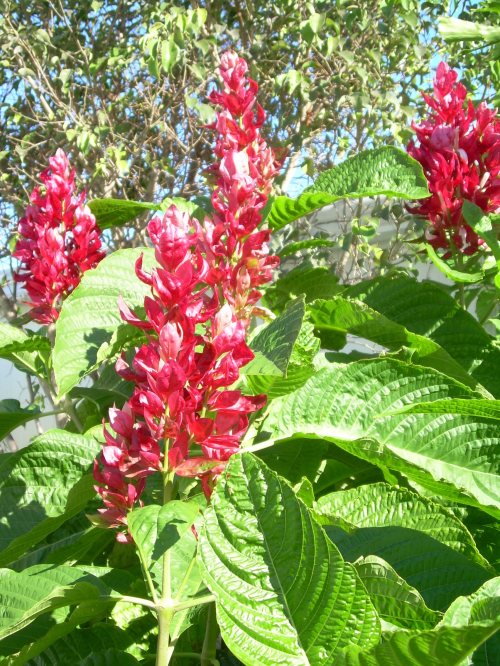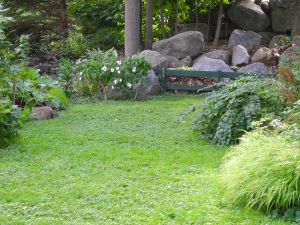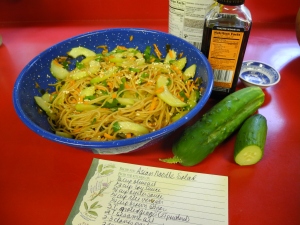According to “Tropical Topics”online newsletter by Ellen Wells, horticulture students in the Southeast, may qualify for one of 12 $1,500 scholarships awarded by the Sidney B. Meadows Scholarship Endowment Fund. Juniors, seniors and graduate-level students who are residents of the 16 southeastern states could be eligible. Deadline is May 27, so if you think you’re eligible, check out the requirements and fill out the application at the Fund’s website, www.sbmsef.org/. Scholarship recipients will be determined by July 6 and notified soon after.
Plant profile: Caricature plant
January 19, 2016

A recent visit to Mounts Botanical Garden in West Palm Beach introduced me to a few “new” plants. Because I visited on a Monday (the garden’s Nursery Guild plant sales section are open from 10 a.m. to 1 p.m. Mondays and Fridays) I was able to buy my one of my favorites seen there, caricature plant (Graptophyllum dictum), often commonly called Jamaican croton. I especially like that this colorful tropical is good for the shade where crotons ordinarily would struggle.
This plant also does well in full sun. In both situations it lends a delicate dance of color and contrast with splashes of pink on green with deeper-colored stems. There are other cultivars with slightly different shades. This tropical specimen is a native of New Guinea and is in the family: Acanthaceae. Caricature plant is recommended for Zones 10-11, although with research I found that roots can survive down to 25 degrees. And it blooms with four-inch long red or purple inflorescences on this evergreen shrub which grows two to eight- feet tall, with a two to five-foot spread. It displays glossy, leathery, elliptic leaves, up to six inches long. Keep soil uniformly moist. As an extra bonus, softwood stem cuttings will root in water. A good thing, because this is another of those plants that you will want to share with your gardening friends.
.
Plant profile: Brazilian cloak
January 8, 2016

Whenever I invite someone into my garden to take a peek at the Brazilian cloak (Megaskepasma erythrochlamys), their usual response upon spying the brilliant one to two-foot tall spikes of blooms is to drop their jaw in absolute awe. I can’t help but do the same whenever my eyes land on this stunning specimen. Hummingbirds seem to have the same reaction as well.
This showy tropical will remain in bloom, setting new blooms continually and retaining old blooms for months throughout the fall, winter and early spring. Topping out at about 15 to 20 feet, Brazilian cloak cannot be equalled in the tropical garden. Able to withstand temps down to the mid-20s, it could well be considered a good choice for subtropical gardens (Zone 9b) as well. Although I would be prepared to cover it or have it in a container that could be moved to a safe place in the event of a hard freeze.
Adequate moisture and a rich growing medium are a must to keep the big, textured leaves green. Also consider planting something at its “feet” to fill in the area below as Brazilian cloak can be a bit leggy. It can be propagated from cuttings, which is a good thing because once your friends and neighbors see this beauty, they’ll want to grow it too.
Plant profile: Stromanthe
December 9, 2015

Color in the shade, is one big gardening challenge. But up to that test is a tropical plant that meets it with color and presence. Tricolor ginger (Jengibre Tricolor) ‘Tricolor’ does have some cold-hardiness, and I have been growing it successfully in a protected location in Zone 9B for years.
Just one look at this stunning plant shows that you don’t need blooms to create a brilliance and a stir in the shaded garden. Though some pot/plant tags suggest this as a plant for full sun (six hours direct sun), it is likely you’ll find that sort of exposure will burn the colorful foliage of this plant. Put it in the shade, and you’ll both be happy.
Stromanthe ‘Triostar’ will eventually grow to about three feet tall with a spread of the same dimension. Give it plenty of water and a rich growing medium for best performance. In colder climes this could be one of your favorite houseplants ever.
Creating a focal point
September 20, 2015
I have been moving shrubs around. (Hope all of them survive the transition!) and moved two rose of Sharon bushes Friday, from beside the house to the back of the yard, just to the left of my compost area. They are a variety called ‘Lil’Kim’ which does not grow as tall as do many of the roses of Sharon. The change will “soften” the boulders that surround the compost pit, and do a lot more too.
The result has been dramatic! Where those two bushes, that I had to constantly cut back because they were just too big for where they were and were almost eyesores — have now become a focal point and pull the eye to the back of a long stretch of lawn bordered by perennials and shrubs. They have big white blooms with scarlet centers in late summer. Where it was formerly mostly green, now there are these big white blooms that just pop out and draw your attention to them. Amazing transformation.
I also moved five hydrangeas from obscure positions out to the edge of the yard where they can grown big and provide a collar of color in the back yard. Formerly they too had been tucked here and there and had to be cut back frequently. Now they can spread and look glorious.
I got the idea to start moving things around after seeing a neighbor’s garden that is simply gorgeous. A real inspiration. Now, I am keeping my fingers crossed that everything survives. I really had to hack those roots back on those two rose of Sharon bushes.
And the same neighbor who provided me with the idea to move things out into prominent areas, gave me some cuttings from a chartreuse (rare color) forsythia that I am getting to root. Hopefully that will add some more color back there once it gets going.

Asian noodle salad features cucumbers
September 10, 2015
When those cucumbers start coming in, they come on strong. Of course we’ve enjoyed them in salads and as fresh dill pickles (https://gardeningonthego.wordpress.com/2011/09/13/making-fresh-refrigerator-dill-pickles/) and all by themselves. But lately I have been searching for something else to do with cucumbers.
Then I “discovered” this totally cool Oriental-style noodle salad that is perfect for these warm end-of-summer days. My recipe has lots of room for improvisation. Indeed, latest bowl that I mixed up contained bits of dry seaweed which was chopped fine and cooked along with the pasta. Or try adding some steamed, diagonally-sliced snow peas or tender green beans for example. Or maybe slivers of some different greens?
This recipe makes a lot, which is good because you’ll want to share. Or if you don’t want to share, you’ll have plenty for yourself. (Warning here: This stuff is positively addictive.) I usually divide the ingredients by half, which results in about a quart and a half of salad, or a good-sized bowl full. That’s enough for four to enjoy it as a main dish or side. The whole recipe is great to take to those pot-luck meals.
Asian Noodle Salad
8 ounces angel-hair pasta, broken into thirds
1/2 cup olive oil
2 tablespoons toasted sesame oil
1/3 cup soy sauce
1/4 cup white rice vinegar
1/4 cup brown sugar
3 tablespoons grated ginger, or two teaspoons dry
2-4 cloves garlic, mashed and minced
1/2 cup chopped cilantro or flat-leaf Italian parsley
2 carrots, shredded
4 cucumbers, peeled, halved (and seeded if necessary), sliced thin
1/2 cup sliced green onions, or chives
Shredded fresh spinach or kale if desired
2 tablespoons sesame seed, more if desired
Cook pasta according to package directions, drain and set aside as you combine all the other ingredients in order given in a large bowl. Stir in pasta. Chill for at least an hour to let flavors mingle. Serve cold. Serves 8.
Compost — it’s not rocket science
August 6, 2015

At the bottom is the newer pile where fresh materials are added, and the almost-composted pile is at the top finishing up.
If I have to listen to another person’s excuses for not composting I think I am going to scream. They say they have no carpentry skills, and can’t make a bin or cannot afford to buy a bin: You don’t need a bin. All you need is a pile and — yes — it will work.
They say they don’t have time: If you have time to put it in the garbage, you have time to put it in the compost pile. They say they are afraid it will look bad: It does not. They say they are afraid it will stink: It will not. They say they are worried that animals will scatter it: If you don’t add meat to the pile — which you should not — you won’t attract animals. If you want to put bones in there, lobster or mussel shells for instance, dig them down deep and cover them up and nothing will bother them.
Seriously, folks, composting is not rocket science. Oh yeah, I already said that. I know there have been books written about composting and formulas and yadda, yadda, yadda… But really all you need is a simple pile and it will work. Include garden clippings, dried leaves, grass clippings, kitchen fruit and vegetable trimmings (no meat nor fat which can slow down the composting process), coffee grounds, egg shells, tea bags, etc. and if you make a place for them it will compost.
For years I had just such a pile, still do, and it works just fine. Last year we put in three posts and a couple cross pieces to sort of “fence it” off since it is right in sight of the back yard. Even so, it never was unsightly, never had an odor or other caused any problem at all. And basically it is still just a pile.

We put up a couple posts with cross pieces to conceal the compost pile. No bins needed. The compost would work without the little fence and wasn’t unsightly before it was added.
Here’s what I do:
• In the fall all the raked leaves and garden trimmings go into the compost area. In fact they swallow it up. All winter kitchen trimmings go into the leaves. I just bury new stuff down into the leaves.
• In the spring I turn the whole thing with a pitch fork. By then the leaves have settled down some and are actually wet and matted. Turning the pile incorporates some air into the ingredients.
• All summer I add new stuff from the kitchen, yard and garden trimmings.
• About half way through the summer I turn the pile. By then there usually is a nice layer of almost-composted material on the bottom. I fork the uncomposted things to one side and rake the mostly-composted material into a second pile to finish working.
• By late summer the second pile is completely composted, and I remove it to spread on the beds. The newer pile is turned and piled up to be left to work, and a new pile is started where the removed compost used to be. Still two piles.
• By fall the older of the two piles is ready to be used. That’s also when I cut back gardens and add a lot of green material along with the fall leaves. And the process begins again…
Composting does a lot of good things. FIrst of all it creates beneficial soil supplements that are completely free. Not only is compost free, compost provides your plants with beneficial microbes that do more than just feed them. It also makes them healthier plants and eliminates the need for commercial fertilizers. Composting keeps garbage out of the landfill. It is a simple way you can help the environment and yourself. It’s simple, it’s easy and if you garden you need a compost pile. So, why aren’t you composting?
Bee banquet
June 26, 2015
One of the things that happens when you sign up for one of those lawn services that treats your grass with a cocktail of pesticides/herbicides/fungicides and fertilizers is that you end up with a monoculture. That’s it, just one type of grass.
Aside from all the poisons that are being added (Why else are those little skull and crossbones signs posted after every treatment?) and the problems that creates for you and your pets and the environment, your lawn becomes just about as helpless as a newborn babe. That means your baby of a lawn becomes an easy target for any disease that comes along the pike, and is then a chem-junkie that cannot survive without frequent “treatments.” You and your lawn are now hooked.
On the other hand IF you were to forego the chemicals and say, seed in some different grasses and clover to your mix you not only get a green lawn that benefits — rather than threatens — pollinators. The clover helps to fix the nitrogen in the soil, which in turn feeds the various grasses. In effect the lawn is “feeding” itself. It’s what they call a win-win, for your grass, for the environment and your pocketbook as well.
Lately we have been leaving patches of the blooming Dutch clover for a honeybee banquet. Other pollinators enjoy it too. Plus by letting it bloom and go to seed, we are getting more than one benefit. Okay, I’ll admit it is pretty much a low-impact improvement, but hey, it’s summer and the living should be easy.
Flowering shrubs for early blooms
June 25, 2015
Considering the feet of snow that covered the sunny border last winter, it seems hard to believe how quickly the flowering shrubs shrugged off the dormant season and put on their spring show.
One of the first to display its finery was the Snow Day ‘Blizzard’ pearl bush with its impressive flurry of snow-white white blooms.
The ornamental quinces were next and there is nothing subtle about their spectacularly brilliant flowers. Deep orange, pink and red balls crowd the branches of Double Take series ‘Orange Storm, “Pink Storm” and ‘Scarlet Storm” quinces.
Not to be overshadowed, the Yuki Cherry Blossom Deutzias chimed in next. These sweet little shrubs are compact and form colorful groundcovers. Be warned, however, you are bound to fall in love with this unique choice.
When it comes to early impact, count on the Weigelas. ‘Sonic Bloom Red’ not only provides brilliant purple/pink blooms, but reblooms through the fall on spreading plants.
Oh yeah, the hydrangeas and bush roses are coming along and they will be spectacular, but thank goodness for those early spring bloomers that get the garden started with color, form and interest.
Quickie Coconut Soup
May 22, 2015
Quick and easy to make with things you probably already have on hand, this Asian-inspired soup begins with an envelope of dry chicken noodle soup mix. It is full of flavor, character and a bit of crunch too. Without further ado, here it is:
Quickie Coconut Soup
1 envelope dried chicken noodle soup
3 cups water
1/3 cup one-inch pieces of thin spaghetti, soba noodles or dry noodles
1 cup coconut milk (approximately half a can, wrap and freeze the rest for another time)
Juice of half of lemon or lime
Dash red pepper flakes
Julienne sliced leaf lettuce, Romane is good but any leaf lettuce will do, about a cup per soup bowl
Chopped chives for garnish
Add ons can include: corn kernels sliced from a cob, shredded chicken or tofu, etc.
• Slice up lettuce and place about a cup of shreds in each soup bowl. Set aside.
• Bring three cups water to boil. Add dry soup mix and pasta and boil gently for approximately 10 minutes or until pasta is done. Stir in coconut milk, lemon juice and red pepper and any add-ons you desire. Bring to a boil again.
• Ladle hot soup over lettuce in bowls. Garnish with chives. Makes four servings.








